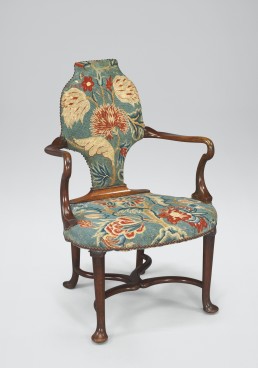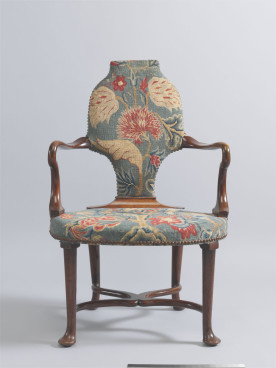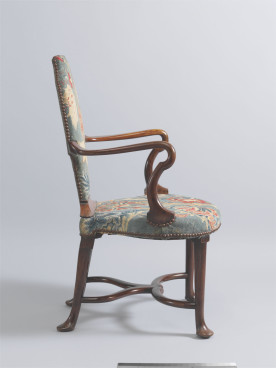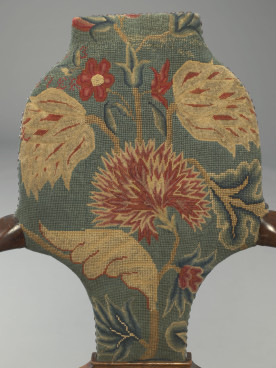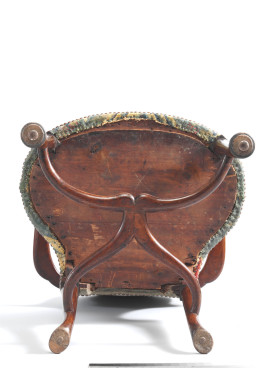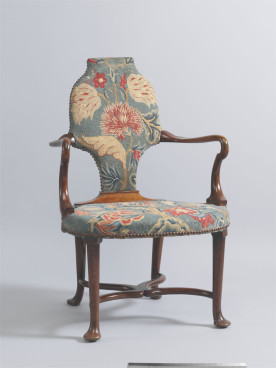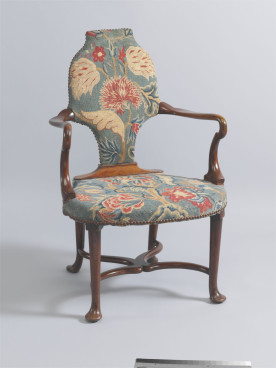Armchair, c.1720–35
Walnut, now with 18th-century needlework
The low, cut-away back indicates that this is probably a dressing chair.
Adam Bowett Catalogue (19/08/2012)
Description
An armchair, c.1720-35. The escutcheon-shaped back and compass seat are covered in close-nailed floral woollen needlework, the back closed with faded blue cloth. There is a wooden ‘shoe’ at the base of the back. The ‘shepherd’s crook’ arms are raised on curved supports and the turned front and back legs have pad feet and are joined by a wavy X stretcher.
Dimensions
H: 36” (92cm) Seat height: 16 ¼ ” (41cm) W: 23 ¾ ” (60cm) D: 20” (52cm)
Materials
Walnut, beech, softwood, various upholstery materials
Dating criteria
Chairs of this form are conventionally though to be ‘Queen Anne’ or early Georgian in date. The raised, squared-off top to the back reflects the fashion for ‘scrowled tops’ introduced about 1715, while the turned front legs are late variants of the ‘pillar’ leg introduced in the 1690s. The shape of the shoe corresponds to those found on contemporary baluster-back chairs from about 1720 onwards.
Construction
Most of the back construction is concealed by upholstery, while the seat frame is largely obscured by a deal board nailed to the underside. The front legs are probably tenoned or dovetailed up into the seat rails. The side rails are tenoned into the back legs, and the back rail similarly tenoned into the back legs. The stretcher is made in three parts; the front section spans the front legs in a continuous curve, while the back section is in two parts, one to each back leg. The two back sections are joined (probably mortised-and-tenoned) longitudinally at the center and then tenoned into the front section. This latter joint is secured by two small pegs. The stretcher appears to be fixed to each leg by a recessed screw concealed by a plug in the outside face of the legs. The base of the seat is enclosed with a softwood seat board (a repair). The arms are made in two parts, the lower section probably tenoned or dovetailed into the seat rails, the upper section probably housed and screwed to the back frame. The joint between upper and lower parts is probably secured by a mortise-and-tenon. The wooded shoe, which fits snugly around the base of the back, is fitted on top of the upholstery.
Condition
The chair has seen extensive use. Both arms have probably been detached from the back and re-fixed; the right arm has repairs to the joint between upper and lower sections, ditto left arm. There is evidence of damage to the base of the left arm. Back left foot repaired. The joints to all four legs into the seat rails have been repaired, probably more than once. The softwood board enclosing the underside of the seat is probably a repair intended to support collapsed webbing and upholstery. The wood appears to be American white pine (Pinus strobus L.), widely used in England in the nineteenth century. The use of hand-made nails to secure the board suggests this was done in the first half of the 19th century. One of the implications of this is that the upholstery cannot be original. There are metal domes, or gliders, fixed beneath each foot.
Additional remarks
Probably a dressing chair.
References
The Antique Collector, June 1960, X.,
Lanto Synge, Mallet’s Great English Furniture, London (1991), p. 46, fig. 37. Adam Bowett, Early Georgian Furniture, 1715-1740, Woodbridge (2009), p. 188, fig, 4.91.
For dressing chairs, see Lucy Wood, Upholstered Furniture in the Lady Lever Art Gallery, 2 Vols., New Haven and London (2008), I, pp. 38-40; Adam Bowett, Early Georgian Furniture 1715-1740, Woodbridge (2009), pp. 188-189.
Provenance
Purchased from Mallett, August 1987

